PinotFile: 6.51 January 20, 2008
|
Russian River Valley-Beaune in USALocated sixty miles north of downtown San Francisco, the Russian River Valley is a box-shaped region in northern Sonoma County just fifteen miles on any side. One of thirteen appellations in Sonoma County, the four corners of the Russian River Valley consist of the towns of Healdsburg and Guerneville in the north and Sebastopol and Santa Rosa in the south. The Russian River Valley comprises 126,600 acres of rolling hills, dense red wood forests and apple orchards with 15,000 acres planted to vineyards (depicted in green on the map below). 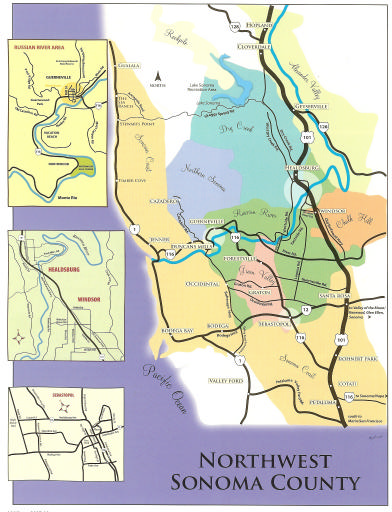
There are many varietals that thrive in the diverse microclimates of the Russian River Valley. It was the so-called “field blends” of varietals such as Grenache, Mourvèdre, Carignane, Petite Sirah, Syrah and Alicante Bouschet along with Zinfandel that the Italian Americans grew so successfully and popularized here. Some of these Italian-American immigrants’ families, such as Seghesio, Rochioli, Pedroncelli, and Pellegrini, are still making wine in the Russian River Valley. With time, the region has become the chosen one for growing the Burgundian varietals, Pinot Noir and Chardonnay. The Russian River is 105 miles in length, beginning its journey in the coastal mountains in the north near the town of Willits in Mendocino County, and winding south through the Alexander Valley before reaching the Russian River Valley. Just below the town of Healdsburg, the River takes a turn to head west toward the Pacific Ocean. The surrounding area here is the so-called Middle Reach of the Valley, the sweet spot and birthplace of modern Pinot Noir viticulture in the Valley. 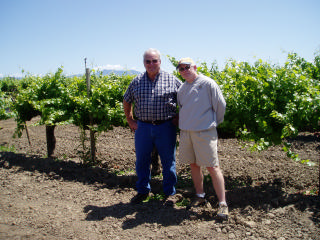 Gary Farrell would often hand-deliver his wines to customers in the Valley, one of whom was Ed Selyem, who was the wine buyer for Speer’s Market in Forestville. In a sfgate.com article dated 8/22/06 written by Linda Murphy, Gary Farrell was reported as saying, “Their (Ed Selyem and Burt Williams) entry into the business caught me by surprise. Ed would ask me about the Rochioli vineyards, about winemaking, and I gave him the recipe. It never occurred to me what he was up to until Joe Rochioli told me that he’d sold grapes to Williams Selyem.” 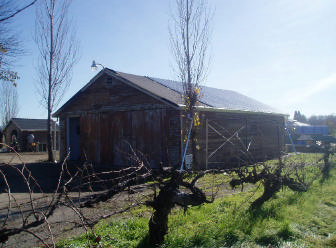 The now legendary Williams Selyem Winery was the original Russian River Valley garage winery. Burt Williams hailed from Sebastopol, worked as a proofreader for the San Francisco Newspaper Agency (Chronicle and Examiner), and made wine at home. Ed Selyem was a wine buyer and accountant for a small grocery store and crafted beer and fruit wine in his garage in Forestville. Together they began making wine from Sonoma Zinfandel grapes for their own use in 1979. Their first commercial winery was based in a rented garage on River Road in Fulton beginning in 1984 (photo right shows a recent photo of the garage). The original name of their winery was Hacienda del Rio, a name Ed used on his first home-crafted wines. The photo below left shows the 1980 Hacienda del Rio label. This wine was produced in Ed's Forestville garage by Ed and Burt for friends and family and was not released commercially. The first three commercial Pinot Noirs, 1981-1983, were made at Russian River Vineyards in Forestville, and bottled under the Hacienda del Rio name. The wines were an instant success and Burgundy lovers began to talk about the Williams Selyem Pinot Noir in revered tones. The Hacienda Del Rio label (below right) looked exactly like the current Williams Selyem label, using the same letterpress lettering, color and paper. A complaint from Hacienda Winery prompted the partners to drop the original name and substitute their own beginning with the 1984 vintage.
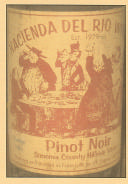 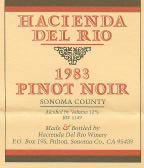 Williams was a burly vintner who had an uncanny and self-taught sense of how Pinot Noir should be vinified. He never set foot in Burgundy. Production methods were old-fashioned to say the least, prompted by the lack of capital. In the early years, Burt continued his job in San Francisco as did Ed at Speer’s Market and they took vacations at crush time. They began with little money, never borrowed, and grew 25% every year by starting small and plowing all of their income back into the business. Wives Gayle Selyem and Jan Williams were also partners in the winery which early on hired no outside help. It was a perfect business partnership as Burt was driven to make world-class wine and Ed was determined to create a successful business from local agriculture. Burt preferred colorful sport shirts with suspenders, Ed opted for t-shirts and boots. Both lived simply and shunned publicity. There was never a sign at the garage announcing the winery’s location and there was no tasting room. 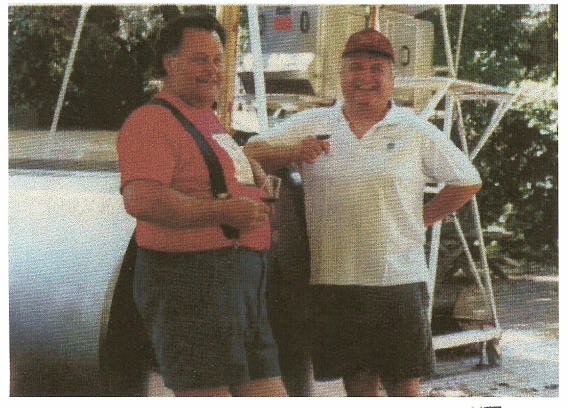
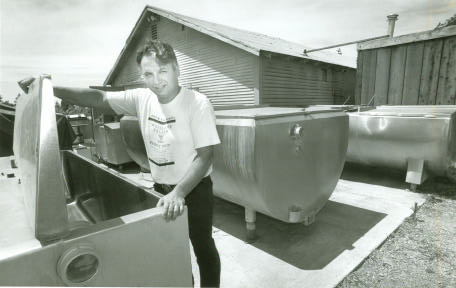
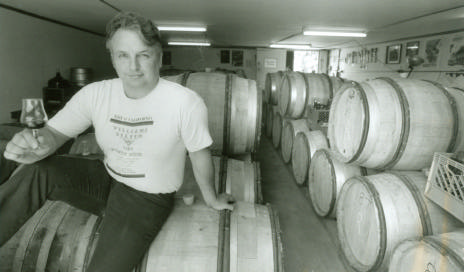 Denise Selyem, Ed’s daughter, recently was kind enough to share two photographs of Ed working at the original winery in Fulton. The picture on top shows Ed outside the garage with the small, double walled, stainless steel, recycled, open-top dairy tanks salvaged from a Windsor dairy farm in which fermentations were carried out. The method of Pinot Noir production employed by Burt and Ed is now currently practiced at least in some form by most California vintners of the Pinot Noir grape. Both Burt and Ed constantly checked on the grapes in the vineyard. The grapes were picked ripe, put into wooden crates and transported by pickup truck to the winery (see old photo on page 6) where they were hand-sorted destemmed. Fermentations were long and cool. They got into the tanks and did some punch downs, but there was no crushing. The must was lightly pressed using a hand-operated basket press dating from 1906. The wine was gravity-racked and the last gallons of juice were lifted out of the tanks in buckets. The wine never saw a pump, a fining agent, or filtration. Aging was carried out in mostly new French oak 225-liter barrels from Troncais made by Francois Freres. The barrels were never used more than twice. The wine was hand-bottled, labeled and foiled. The other photo on page 5 shows Ed inside one of the large shipping cargo containers which were rigged to store barrels. The containers once held New Zealand lamb carcasses. Ed developed the concept of a mailing list to distribute their wine long before mailing lists became the accepted way of allocating scarce wine in California. Early on the wine was sold mainly to other winemakers and retailers with good palates to whom the wine was often hand delivered. 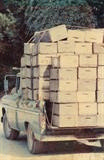 The more wine Williams Selyem made, the more favorable the press that followed, causing a snowball effect in demand. The 1985 Williams Selyem Rochioli Vineyard Russian River Valley Pinot Noir became the most seminal wine in the history of California Pinot Noir. This wine won the Sweepstakes at the California State Fair Wine Competition, voted the best of the 2,136 wines entered by 416 California wineries in 1987. 295 cases of the wine were produced and it sold for $16 a bottle! A copy of the original newspaper article which appeared in the Santa Rosa Press Democrat is on page 7 which includes the photo of Ed I obtained from Denise on page 5. One of the keys to the success of Williams Selyem was that they were able to successfully contract with the very best growers in the Russian River Valley. It was a simpler time and the growers were friendly and unassuming folks that were easy to work with. All of Williams Selyem contracts were on a handshake basis. Williams Selyem never did own any vineyards. Their now famous vineyard sources for Pinot Noir included Rochioli Vineyard, Allen Vineyard, Cohn Vineyard, and Olivet Lane Vineyard in the Russian River Valley, Summa Vineyard, Coastlands Vineyard, and Hirsch Vineyard on the Sonoma Coast, and Ferrington Vineyard in Anderson Valley. In 1989, Howard Allen, owner of Allen Vineyard which was located across Westside Road from Rochioli, built them a winery on his ranch which they leased allowing them to move out of their rented garage in Fulton. Williams Selyem Pinot Noir wine became so popular that a waiting list was developed for those begging to get on the mailing list. Eventually 85% of their wine was sold directly to individuals on the carefully guarded mailing list. Ed managed the list masterfully and enjoyed being in contact with, visiting with, and learning from his devoted customers. 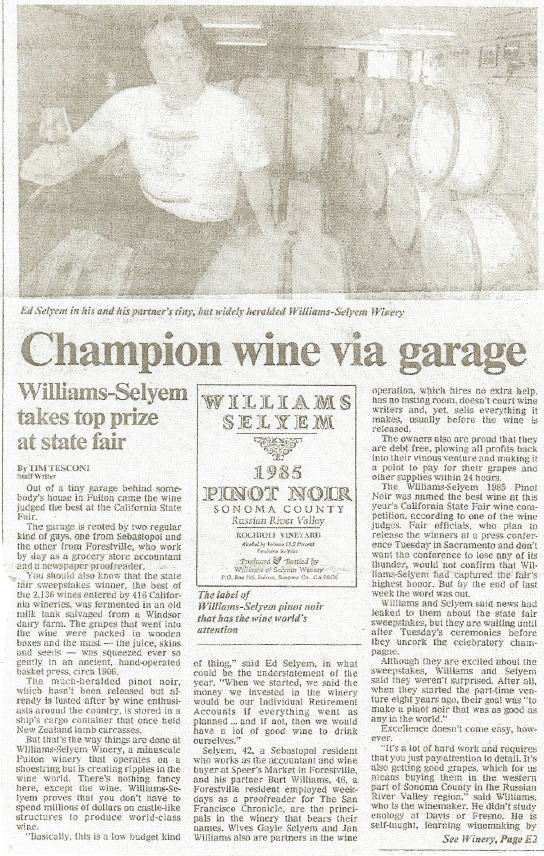 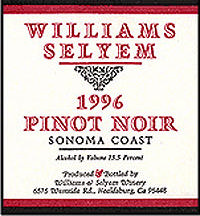
Win Wilson and Jack Daniels, the Napa Valley importers of Domaine de la Romanee-Conti came calling to Williams Selyem in 1992. They wanted to compare wines. 22 wines and 5 hours later, no conclusions were publicly reported, but the reason to do such a comparative tasting indicated the cache that Williams Selyem had gained with the wine industry. The popularity of their wines took their toil over the years on Ed and Burt. Managing the mailing list and the hoards of wine enthusiasts trying to get on the list was a daunting task. Two of the seven fulltime employees in the mid 1990s were designated as “keepers of the list.” Frank Prial, writing in The New York Times (March 19, 1997), related a story about Ed Bradley, a correspondent on CBS’s “60 Minutes,” and a wine enthusiast who wanted to get on the mailing list. Burt Williams said, “He told us that if we didn’t put him on the list, he’d get Andy Rooney to do a commentary on people who keep lists. Well, we couldn’t have that. So we put him on.” The partnership slowly developed some rife and Williams Selyem was put on the market in 1997. It was eventually sold to John Dyson in 1998 for $9.5 million. The official word was that Ed developed serious back problems from lifting wine cases over the years, but the reasons had to be more complicated, yet were never divulged. The last vintage that Ed and Burt vinified at Williams Selyem was 1997, with Burt consulting on the 1998 vintage. At the time the winery was sold, there were 10,000 customers on the mailing list. John Dyson, a wealthy New York politician, was a former New York state agriculture commissioner and a former deputy mayor under Mayor Rudy Giuliani. He owns Millbrook Vineyards in upstate New York and Villa Pillo Estate in Tuscany as well as Mistral and Vista Verde Vineyards on the central California coast. He essentially paid a lot of money for the Williams Selyem name since Williams Selyem owned no vineyards or winery. In addition, he lost some hand-shake agreements such as the grapes from Olivet Lane, Summa and Rochioli’s West Block. Several of the vineyard sources were retained. Ed and Burt almost closed the winery for good before agreeing to sell Williams Selyem to Dyson, a long time member of the mailing list. Upon purchasing the winery, Dyson hired the relatively unknown Bob Cabral as his winemaker. Cabral (customer number 576 on the Williams Selyem list) was the son of grape farmers who earned a degree in enology at Fresno State. He learned his trade at De Loach Vineyards, Knude, Alderbrook and Hartford Court. Since assuming winemaking responsibilities, Cabral has tried to follow Williams’ winemaking methods. After an inauspicious start (it is always difficult to follow a legend), he is producing Pinot Noirs that are still eagerly sought after by the now 15,000 customers on the mailing list. The wines are a touch higher in alcohol, deeper in color, and offer more fruit-driven flavors. As the winery now celebrates its 25th Anniversary with the release of the 2005 vintage, the wines are carrying the flag with respectability and the single-vineyard designates continue to be the stars. Burt now splits his time between his ranch in the Anderson Valley and his fishing boat in Santa Barbara. He grows Pinot Noir on his Morning Dew Vineyard and sells the grapes to his daughter at Brogan Cellars and to Woodenhead and Whitcraft. When I asked him the inevitable question about making his own Pinot Noir again after the non-compete agreement ends next year, he was noncommittal, but said, “If I do decide to do it, I will devote all my energies seriously to the task. I will make small amounts and it will cost a lot of money.” Ed has been spending his summers in Alaska and winters in both California and Hawaii. His daughter, Denise Selyem and her husband Kirk Hubbard, craft Pinot Noirs under the WesMar label, working in a small winery in Sebastopol reminiscent in size of the original garage that Ed and Burt started with. Over the years, Williams Selyem became a training ground for many other winemakers and a number of labels carry on the legacy including Papapapietro Perry, Woodenhead, george, Cobb, and Anthill Cellars.
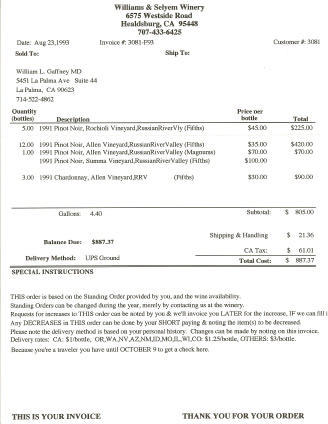
Tasty Pinots from the Russian River ValleyThe following Russian River Valley Pinot Noirs were tasted recently. All of them were commendable, some even more considering their price/value ratio. They are listed in no particular order. De Loach Vineyards De Loach Vineyards celebrated their 30th vintage with the release of the 2005 vintage. This venerated Russian River winery encountered financial difficulties and entered bankruptcy in 2003, eventually being purchased by the Boisset Family Estates of France. Since the change of hands, the winery has reached new heights. Accomplished winemaker Greg LaFollette (below) has been given the reigns, biodynamic farming of the estate’s 22 acres has been instituted, and the wines have continued to reach improve with every vintage. 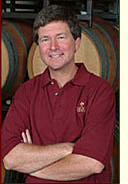  2005 DeLoach Vineyards Russian River Valley OFS Pinot Noir 14.5% alc., $28. This wine is a reserve level Pinot Noir (OFS stands for “Only Finest Selection”). Open-top oak fermenters are used in the vinification. These fermenters offer the advantages of advantageous temperature maintenance, slow and gentle fermentation, and ideal extraction. · Very nice cherry and raspberry infused wine which is elegant, silky and nicely balanced. There are pleasing wood overtones and the lively acid make it a delicious wine with roast chicken.
De Loach Vineyards is located at 1791 Olivet Road, Santa Rosa. The winery is open for tours and tasting from 10-4:30 daily. OFS Reserve wines may be tasted with food for a small charge. The phone number is 707-526-9111 and the website is www.deloachvineyards.com. The winery also produces a Russian River Valley Pinot Noir ($20) which is often served in restaurants, and single vineyard Pinot Noirs including Masut Vineyard ($45), Sonoma Stage Vineyard ($85) and an appellation Pinot Noir from the Green Valley ($45). The wines are in widespread retail distribution.
Balletto Vineyards John Balletto started farming in Sonoma County at the age of 17 in 1977. Today he owns 280 acres in western Sebastopol devoted to wine grapes. 60 acres are planted to multiple clones of Pinot Noir. The western edges of his property are shared with the Laguna de Santa Rosa wetland habitat and are preserved lands. 2001 was the first year that wine was made under the Balletto label. The winemaker is Dan Cederquist.
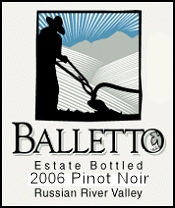 2006 Balletto Vineyards Russian River Valley Pinot Noir 13.9% alc., 3,178 cases, $20. Clones 667, 777, 32, 114, Swan, 37, 9 and 23. Aged 9 months in French oak. · Black cherry nose with a forest floor accent. Nicely spiced fruit flavors. A medium-bodied, light and silky wine which finishes clean. Very enjoyable and a great drink for a Jackson.
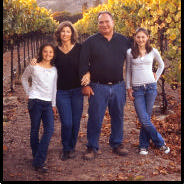
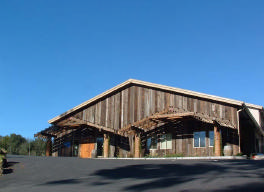 Moshin Vineyards Moshin Vineyardssits on Russian River Valley’s Rodeo Drive of Pinot Noir - Westside Road. Moshin Vineyards winery is one of the few gravity-flow wineries in Sonoma County. Owner Rick Moshin is a former mathematics professor at San Jose State University who has farmed and sold Pinot Noir in the Russian River Valley for several years. His recently built winery was designed to utilize a four-tiered gravity flow system. The costs of building a true gravity flow winery prevent many from accomplishing the task - the retaining walls for the Moshin Winery cost $500,000 alone. The Moshin Winery is built on a hill with the front facing formed from old barn wood to give it an aged look. The crush pad is on the highest or first level. The sorted and destemmed grapes then drop directly into one of the fermenters on the second level. A hose connected to the fermenters directs the juice to the tanks on the third level. Wine then flows by gravity directly into barrels and is stored in the cellar. The bottling room is on the fourth level and receives wine from the cellar into the bottle filler and then the bottle. The winery has all sorts of technological wizardry including custommade, closed-top fermentation tanks, specially made settling tanks, an ozone machine for sterilization, Italian membrane presses and destemmers, a power washer and barrel cleaner, and a pneumatic punch down system. The current permit allows for 30,000 cases. Custom crush is available at the winery and Merry Edwards, Guy Davis (Davis Family Vineyards), and George Levkoff (george wine company) among others have made wine here. Rick Moshin farms a total of 18 acres and produces about 5,000 cases of Pinot Noir each year. Six different bottlings make up the offerings. Moshin has retired from his academic job to pursue winemaking full time. He is a self-taught grape grower and winemaker with over 30 years of experience. The Moshin label dates to 1989 when Moshin traded grapes for crush services with Gary Farrell and Davis Bynum. He remembers way back in the early 1970s when he used to drive along Westside Road dreaming of owning some acreage in the area and now feels blessed to own vineyards here.
 2005 Moshin Vineyards Estate Bottled Russian River Valley Pinot Noir 13.0% alc., 765 cases, $28. · Lovely and fresh cherry and strawberry scents linger in the nose. Straight-forward red fruit flavors are enhanced with a subtle woodsy overtone. Light in body, the wine drinks easy.
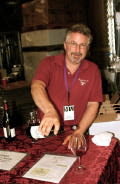
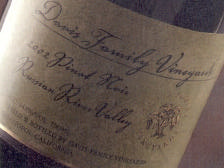 2005 Davis Family Vineyards Russian River Valley Pinot Noir 13.9% alc., 957 cases, $40. Fermented in small temperature controlled fermenters. Each clone was kept separate and blended later according to Davis’s preferences. Aging was carried out for 11 months in 40% new French oak from Allier and Troncais forests, air-dried a minimum of 30 months. · The aromatics need some air to emerge, showing seductive darker fruits The fruit attack is quite pleasing with black cherry, raisin and mushroom leading to a finish with barely perceptible tannins. Nicely crafted and easy to like, it is a very good wine that is still a bit closed and will improve with more time in the bottle. Hold off for another 6 months.
Davis Family Vineyards is located at 52 Front Street, Healdsburg. The tasting room is open from Thursday thru Sunday from 11-4:30. Private tastings by appointment. The wines are largely sold through a mailing list but are available by phone at 707-569-0171 or through the website at www.daviswines.com. Davis also makes and sells an excellent artisan olive oil from the Sierra Foothills. A very consistent and reliable producer.
Dutton-Goldfield This winery is a partnership between winemaker Dan Goldfield and viticulturist Steve Dutton. Steve (left in photo below) is the son of the noted Russian River Valley grape farmer, Warren Dutton, who first planted Pinot Noir in the cool Green Valley region of the Russian River Valley in the early 1970s. The story goes that it was Warren that suggested Steve and Dan form a partnership in 1998. The label was consummated at a Sebastopol pizza parlor with a handshake and the winery has been producing superb Pinot Noir, Zinfandel, Syrah and Chardonnay ever since. Dan is an energetic and high-spirited winemaker who intended to enter medical school. In 1983, he was at a tasting with noted winemaker Larry Brooks (Acacia, Campion) when he had an epiphany, and decided to become a winemaker himself. He received a master’s degree in enology from University of California at Davis and honed his skills at Mondavi, Schramsberg, La Crema and Hartford Court. 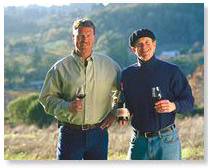 2006 Dutton-Goldfield Dutton Ranch Russian River Valley Pinot Noir 13% alc., $38. · Mineral imbibed black cherry scents evolve in the glass to a purely dark fruit compote which is very alluring. Black raspberry flavors are set off by a hint of oak. The texture is soft and the finish pleasantly tangy with some unresolved tannins. Plenty to like here.
2005 Dutton-Goldfield Dutton Ranch Freestone Hill Vineyard Russian River Valley Pinot Noir 13.8% alc., 361 cases, $58. The vineyard was planted in 1997 on the far southwest edge of the Russian River appellation. Clones 667, 115 and 2A. Aged 17 months in 55% new French oak. · Deep and haunting aromatics featuring black cherries and wild blackberries. A plush mouthful of dark Pinot extract with a hint of herbs, spice and earth. Succulent and robust with a long, scented aftertaste. Beautifully balanced, clean and pure. Power without flab. This one makes you want to clap your hands.
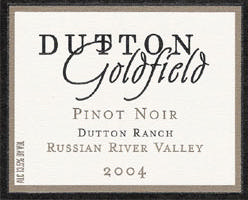 2005 Dutton-Goldfield Dutton Ranch Sanchietti Vineyard Russian River Valley Pinot Noir 13.8%, $58. alc., 343 cases, Goldfield has worked with fruit from this vineyard at La Crema and Hartford Court before bottling it under the Dutton-Goldfield label beginning in 2002. · A fruit driven beauty with demure dark red Pinot fruits that are elegant and juicy. More subdued and sensuous than the Freestone Hill with well-concealed tannins, it will be even better with more time in the bottle.
2005 Dutton-Goldfield McDougall Vineyard Sonoma Coast Pinot Noir 13.8% alc., 250 cases, $58. From the true Sonoma Coast, close to Hirsch Vineyard at 1,100 feet. Yields were about 1 ton per acre. · Enticing nose of blue fruits, plum, ocean air and earth. Supple in the mouth with delicate wild berry fruits, suave tannins and a snappy, clean finish.
Dutton-Goldfield wines are made at Balletto where they share a tasting room (see page 10-11 for details). All of the Pinot Noirs clearly stand out and are extremely well crafted. As they should, each wine reflects a different terroir and it is to Dan’s credit that he lets the wines show off their distinctive terroir- driven traits. The wines are largely sold through a mailing list but are available on the website at www.duttongoldfield.com. The phone is 707-829-6766. Wine club discount is 15%. Magnums are available. Annual production is 9,000 cases.
Williams Selyem I must admit that I have been a bit reticent about Williams Selyem Pinot Noirs since the winery was sold. The prices have seemed to escalate noticeably and my allocations have shrank. Recently, however, what I have tasted has been drawing me back and I think Bob Cabral (pictured below) is really hitting his stride.
2004 Williams Selyem Rochioli Riverblock Vineyard Russian River Valley Pinot Noir 14.4% alc., $72. · Voluptuous Bing cherry perfume which draws you in and won’t let go. Pure and precise dark cherry flavors with a sidecar of sassafras and oak. Full-bodied, rich and full on the mid palate, clean and refreshing at the end. The texture is silky and sensuous. A very classy wine and one to buy for sure.
2004 Williams Selyem Russian River Valley Pinot Noir 13.9% alc., $42. Sourced from several vineyards, mainly the winery’s Drake Estate Vineyard in Guerneville. · Cherries, herbs, oak and port aromas lead to a mouthful of bright Bing cherry fruit and a sidecar of clove and other spices. A pleasurable drink that would be better enjoyed at the dinner table then sipped for contemplation.

Merry Edwards Merry Edwards, often called the “Queen of Pinot,” has been a spokesperson for Russian River Valley Pinot Noir and her wines have been best sellers on restaurant wine lists in this country for many years. She has been making wine for 35 years including stints at Mt Eden (where she worked from 1974 to 1977 and developed the Mt Eden clone of Pinot Noir - UCD 37), Liparita, Matanzas Creek, and Pellegrini Family. In 1997, she started her own winery and released a Russian River Pinot Noir and an Olivet Lane Pinot Noir. Unlike many women who craft Pinot Noir, her wines are bold expressions of the grape and typically show flavors of black cherry, dark chocolate, mushroom and lavender. She noted in Wine & Spirits (Fall, 2004), “We work with a grape deficient in phenolics and tannins. I’m going to do what I have to do to maintain them.” She currently crafts Pinot Noirs from several Russian River Valley sources including Flax Vineyard, Olivet Lane Vineyard (my favorite), Tobias Glen Vineyard, Klopp Ranch Vineyard and her own ( with husband and business partner Ken Coopersmith) 24-acre Meredith Estate Vineyard and 9-acreCoopersmith Vineyard. She made some lovely Pinot Noirs from Windsor Gardens Vineyard but this vineyard was a victim of housing development a few years ago. She was chosen Winemaker of the Year by the San Francisco Chronicle in 2004.
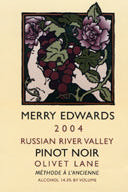 2005 Merry Edwards Tobias Glen Vineyard Russian River Valley Pinot Noir 14.3% alc., $51. · The wine starts off with aromas of red cherry, forest floor and oak. The oak continues throughout ending in a dry and woodsy finish. The wild berry fruit is stacked and packed.
2005 Merry Edwards Meredith Estate Russian River Valley Pinot Noir 14.4% alc., $54. · The aromatics display oak-dusted black cherries and blackberries.. The ripe dark fruits are cloaked in oak on the palate and the wine finishes with plentiful herbal notes, a slight bitterness and healthy tannins.
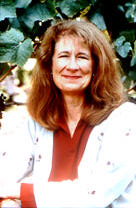
Radio-Coteau A very small boutique producer of Pinot Noir from cool vineyards on the Sonoma Coast, in the Russian River Valley and Anderson Valley that proprietor Eric Sussman manages organically. Sussman began his training in France at Domaine Armand in Pommard and Domaine Jacques Prieur in Meursault. Upon returning to Northern California, he worked at Bonny Doon and Dehlinger. After crossing paths with Bill and Joan Smith, the owners of W.H. Smith, Sussman became partners with them in Radio-Coteau Wine Cellars. Production is only 2,600 cases annually of Pinot Noir, Chardonnay and Syrah. He employs a hands-off style of winemaking which starts with a 7-10 day cold soak, fermentation with natural yeasts, and nothing is added or removed. He doesn’t fine or filter and allows his wines to sit on the lees for 16 months with no racking. Sussman is fanatical about quality.
2005 Radio-Coteau Alberigi Vineyard Russian River Valley Pinot Noir 14.4% alc., 436 cases. This vineyard is exclusively sourced by Radio-Coteau and lies in the Vine Hill road area. · The nose offers confected and oak-spiced darker Pinot fruits. Richly layered blackberry and black raspberry extract with noticeable but not intrusive tannins. Well-rounded and immensely satisfying now, it is still a touch awkward and will benefit from more time in the bottle. A great expression of Pinot Noir.
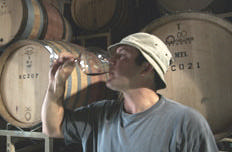
Papapietro Perry Ben Papapietro grew up in a family of home winemakers and wine lovers. He developed a passion for Pinot Noir early on after tasting a number of Burgundies from the mid-1950s. He struck up a friendship with Burt Williams of Williams Selyem fame while both were working at the San Francisco Newspaper Agency. In the 1970s, Ben was helping Burt make his homemade garage wine and he continued to work each harvest at Williams Selyem after the winery was started in the early 1980s. Ben began making his own homemade wine in 1980 and a few years later was joined by Bruce Perry, another fellow worker at the San Francisco Newspaper Agency. Upon the urgings of family and friends, they started Papapietro Perry in 1998 with an initial release of 75 cases of Pinot Noir. Today they produce well-regarded small lots of Pinot Noir from prime vineyards on the Sonoma Coast and in the Russian River and Anderson Valleys. 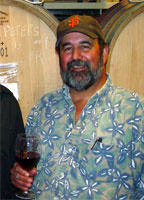 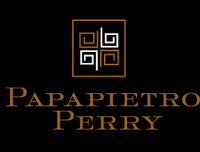 2005 Papapietro Perry Leras Family Vineyard Russian River Valley Pinot Noir 14.5% alc., 950 cases, $46. This vineyard is located off Woolsey Road and is planted to Pommard, 115, 667 and 777 clones of Pinot Noir. The wine was aged for 11 months in 50% new Francois Freres oak. Lovely hi-tone cherry aromas. · Flavors are cherry driven with attractive side notes of herbs, cocoa, cola, spice and a pinch of oak. Modest in weight and light on its feet, this wine oozes finesse and charm. Well crafted and recommended.
Papapietro Perry wines are available through retail channels and on the website at www.papaietroperry. com. A tasting room is open daily from 11-4:30 at 4791 Dry Creek Road in Healdsburg. The phone is 707-433-0422. The wine above is sold out at the winery but may be available at fine retail stores.
Aubin Cellars Verve Jerome Aubin is a Frenchman who grew up in Burgundy near Beaune. He resides in Northern California where he imports French and Hungarian oak wine barrels. Along with winemaker Laren Tayerie, he crafts small lots of Pinot Noir from the Sonoma Coast and Russian River Valley from a small winery in Novato. Aubin also produces a Pinot Noir from the Dundee Hills at Carlton Winemaker’s Studio. The name “Verve” translates to “creative enthusiasm.”
2005 Verve Russian River Valley Pinot Noir 14.5% alc., 375 cases, $33. The grapes come from an unnamed well known vineyard located between Sebastopol and Forestville. The clones are an unusual mix of 115, Beringer, Jackson 9 and Swan. The wine was fermented in a Rousseau 2 ton French oak open-top fermenter and aged for 17 months in 40% new French oak followed by 6 months in bottle. · This wine smelled great with rich black cherry, plum, spice and pleasant oak aromas. Black cherry infused with sidecars of anise, herbs and spice, this medium to full bodied Pinot was soft and smooth in the mouth and left a refreshing impression on the finish. Plenty of Pinot love here.
Aubin Cellars address is 6050 Colton Blvd, Oakland. The phone is 510-339- 0170. The wines are available on the website at www.aubincellars.com and through fine retail shops. There is a mailing list. No tasting or tours.
Lynmar Winery The Fritz family purchased the Quail hill Vineyard in 1980 and founded Lynmar Winery in 1990. In 2004, the winery launched a five-year investment plan to complete a phased replanting of Quail Hill. An impressive new winery and hospitality center was added. Winemaker Hugh Chapelle (and consultant Paul Hobbs) have brought Lynmar to a world-class level. Lynn Fritz is pictured below. 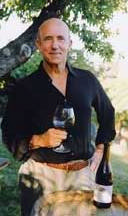 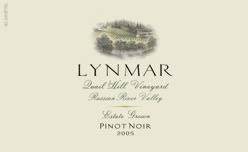 2005 Lynmar Russian River Valley Pinot Noir 14.4% alc., 3,064 cases, $36. A blend of fruit from the estate Quail Hill Vineyard and other vineyards in the Russian River Valley locale. · Restrained scents of cherry, herbs and forest floor. Lovely red cherry fruit imbibed with spice. Soft and gentle, it floats across the tongue.
2005 Lynmar Quail Hill Vineyard Russian River Valley Pinot Noir 14.4% alc., 1,459 cases, $60. Primarily Swan selection from the estate Quail Hill Vineyard. Aged 16 months in 45% new French oak. · Deep, dark ruby in color. A penetrating, rich nose with dark Pinot fruits, forest floor and restrained oak. Gamy and earthy with plenty of black fruit front and center. Very smooth in texture, seamless throughout with a healthy tannic structure. More body, more flavor, more of everything compared to the Russian River Valley bottling
Lynmar Winery has a beautiful hospitality center and tasting salon overlooking the estate vineyards. The center, located at 3909 Frei Road in Sebastopol, is open daily from 10-5. The Lynmar Food and Wine Experience pairs small appetizer-sized foods with each of the Lynmar wines. Tours are by appointment. The wines are available on the website at www.lynmarwinery.com. The phone number is 707-829-3344. Lynmar has released its first vineyard-designate Pinot Noir from outside the Estate, the Jenkins Vineyard Russian River Valley Pinot Noir. There is also a reserve bottling, the Five Sisters Pinot Noir which is spectacular. The Chardonnays and Vin Gris of Pinot Noir are first rate as well. A very classy operation with noteworthy wines.
Dain Wines David Dain Smith produces small amounts of several vineyard-designate Pinot Noirs that are vinified at CrushPad in San Francisco. He still resides in Missouri and commutes to craft his wines. Each of the wines are named for a prominent now-deceased family member (David’s maternal grandmother, Cora Whitley Duffer, is pictured on the label of American Beauty reviewed below. Look him up at any of the Pinot Festivals in California - he has an infectious smile and is a great guy to talk Pinot with. 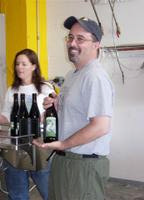
 2006 Dain American Beauty Amber Ridge Vineyard Russian River Valley Pinot Noir 14.1% alc., $48. Dijon clones 115, 667. Aged in 50% new French oak. · Attractive aromatics featuring Bing cherry and wood spice. Red fruits and cola compose the taste track. Very soft and elegant with ample acidity. The aftertaste lingers with a woodsy bent. The fruits are a little shy at this point and more bottle age should change this.
Dain Wines are sold primarily through a mailing list at www.dainwines.com. The phone is 417-860- 2715.
Olson Ogden Wines John Ogden and winemaker Tim Olson started a boutique winery in Sonoma County in 2002, making about 1,000 cases a year of Rhone varietals and Pinot Noir. Tim Olson began crafting wine in his home garage over 20 years ago. A film major in college, he developed enough of a passion for wine that to gain experience, he began working for free at Caymus for Charlie Wagner. Before long, he was rewarded with a paycheck for his hard work and he has never looked back. He made some excellent wines for Tarius before starting Olsen Ogden Wines. Olsen Ogden has gained some national press recognition for their Unti Vineyard Syrah.
2005 Olson Ogden Wines Russian River Valley Pinot Noir 14.4% alc., 190 cases, $35. · Appealing Pinot perfume accented with floral and cherry scents. Delicate red fruit flavors with a touch of dust and spice. Quite decent.
Olson Ogden Wines are sold through a mailing list at www.olsonogdenwines.com. There is some retail distribution. The phone is 707-823-6127.
Barnett Vineyards At 2,000 at elevation on Spring Mountain in the Napa Valley, Fiona and Hal Barnett created a vineyard and winery specializing in Cabernet Sauvignon. They make limited amounts of Merlot, Chardonnay and Pinot Noir. Total production is 6,000 cases. The current winemaker is David Tate who comes to Barnett from Ridge where he as an assistant winemaker.  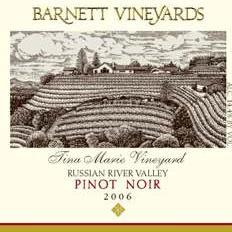 2006 Barnett Vineyards Tina Marie Vineyard Russian River Valley Pinot Noir 14.4% alc., 1180 cases, $40. Tina Maria Vineyard is in Green Valley, a sub AVA of the Russian River Valley, planted entirely to Dijon clones. · Complex aromatics dominated by blackberries and black raspberries complimented by herbs, hay, oak and barnyard. Juicy and succulent dark fruits with an oak sidecar running throughout. Rich and smooth in texture with integrated tannins. Well-crafted, easy to like and very approachable.
Barnett Vineyards wines are sold on the website at www.barnettvineyards.com. There is some retail distribution. The winery and vineyards are located at 4070 Spring Mountain Road, St. Helena. The phone is 707-963-7075.
Rutz Cellars Owner Keith Rutz crafts Pinot Noir in the style and flavor of the great Burgundies of Vosne-Romanee and Chambolle-Musigny. His unique winery in Sebastopol is housed in a 5,000 square foot extending 300 feet into a hillside. 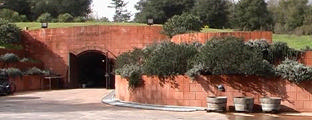 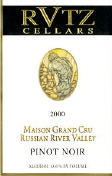 2005 Rutz Cellars Maison Grand Cru Russian River Valley Pinot Noir 14.5% alc., $35. · Very light in color. The nose is quite charming exhibiting crushed strawberries, exotic woods, spice and a floral lift. A very elegant wine with delicate red Pinot fruits with oak accents. This is a wine for those who prefer the feminine side of Pinot Noir.
Rutz Cellars produces several other Pinot Noirs including two blends - French Cuvee and Sonoma Cuvee - as well as vineyard-designates including Windsor Gardens, Dutton Ranch and Burnside. The wines are sold on the website at www.rutzcellars.com. The caves and winery are located at 3637 Frei Road, Sebastopol. 415-482-6565. Tours and tastings by appointment.
J Vineyards & Winery Judy Jordan founded J in 1986 to produce sparkling wines of distinction as well as still Pinot Gris and Pinot Noir. The winery’s vineyard holdings encompass 274 acres of diverse hillside, bench land and valley floor plantings. The J sparkling wines have been exceptional through the years, but the still Pinot Noirs have failed to distinguish. Last year, George Bursick, the former winemaker at Ferrari-Carano, was brought in along with viticulturalist John Erbe to transform J with an emphasis on site-specific Pinot Noir. The 2006 vintage will be the first to fully show the fruits of their efforts. 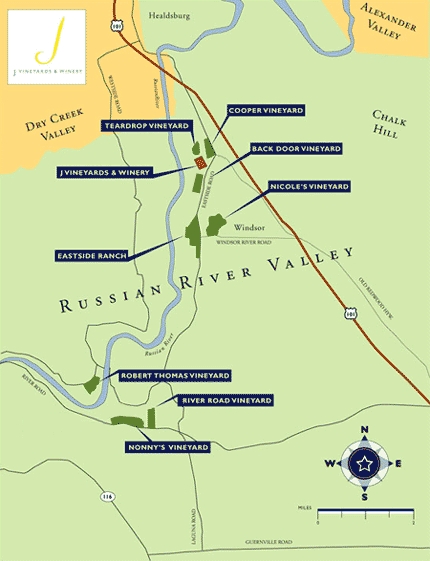 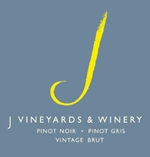 2005 J Russian River Valley Pinot Noir 14.5% alc., 22,000 cases, $32. A blend from all of the estate vineyards. Aged 11 months in 30% new French oak. · Rich scents of wild berries and cherries. Subdued red and blue fruits with a leafy and toasty edge. Decent but lacks energy and excitement.
J Vineyards & Winery has a beautiful tasting and hospitality center at 11447 Old Redwood Highway in Healdsburg, and offers special tasting experiences with wine-food pairings. The wines are in wide retail distribution and offered on the website at www.jwine.com. 707-431-3646.
Pinot BriefsPricey Wines Preferred Researchers led by Antonio Rangel and colleagues at the California Institute of Technology (Cal Tech) had 20 volunteers (inexperienced wine drinkers) rank their enjoyment of five Cabernet Sauvignon wines tasted while an MRI machine monitored their brain response. They were told they were tasting different wines sold at varying prices. In fact, two sets of wine samples were identical - the $5 and $45 wines (both the same $5 wine) and the $10 and $90 wines (both actually were the $90 wine). The brain scans showed that the greatest pleasure activity occurred when the volunteers drank the wine marked $90 and the least activity when they drank the wine priced at $5. The volunteers said they liked the $90 wine best and the $5 wine the least. Two weeks later, the volunteers rated the wines without price data and they liked the wines originally marked $5 and $45 best and the ones labeled $10 and $90 second best. Haven’t we all been influenced by price?  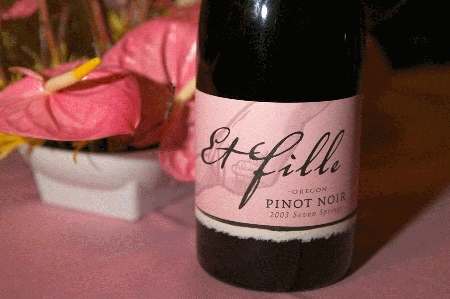 Breathable Wine Glass A German company, Eisch Glaskultur is producing a “breathable” wine glass that is touted as “revolutionizing the industry.” The Eisch glasses are made from a special leadfree crystal that undergoes a proprietary oxygenization treatment. Oxygen can travel through the glass to aerate the wine quickly. The company claims the resulting aeration over four minutes is equivalent two hours of aeration in a decanter. The glasses are $49.95 for a set of two and are available at Weaver Wines in Ventura (805-653-9463).  Cyrus Restaurant Wine Dinners The much heralded Cyrus Restaurant in Healdsburg (Michelin Two Stars, SF Chronicle Four Stars. Gourmet #15 of Top 50) has announced its Winter 2008 Winemaker Dinner Series. What an incredible lineup! Chef Douglas Keane crafts seven course tasting menus to complement the wines of the evening’s vintner. January 7th was Screaming Eagle and Jonata with winemakers Andy Erickson and Matt Dees, January 15 was Williams Selyem with Bob Cabral, February 5 will feature Littorai Wines with Ted Lemon, March 5th Margi “Brogan” Wierenga will pour her Brogan Cellars wines, and March 3rd will feature Peay Vineyards with owner Andy Peay and winemaker Vanessa Wong. For further information or to make a reservation, contact the restaurant at 707- 433-3311 or www.cyrusrestaurant.com. Pinot Noir in the Presidio Foggy Bridge, a new winery backed by former Geyser Peak winemaker Daryl Groom and a Silicon Valley investment group plans to build a boutique winery in the San Francisco Presidio National Park, a former United States Army Post. This will be the first winery in a national park and only the second in San Francisco. The plans are for an 8,000 case, 18,000-squarefoot winery-restaurant building to be built within a previous airplane hangar on the former air base. The wines produced will include Cabernet Sauvignon from Napa, Zinfandel from Dry Creek and Pinot Noir from Santa Maria. For the full scoop go to www.pressdemocrat.com. Scott Paul Selections Burgundy Wine Club A wine club, named The Burgundy Express, will hand pick and ship regularly Scott Paul Selections Burgundies to those eager to explore the wines of Burgundy. Each shipment will consist of an educational and informative tasting flight with a specific topic covered in each shipment. Each twice yearly shipment will contain four to six bottles of Burgundy ranging from $175-$250 which will reflect a 20% discount on the wines. Members will also receive a 20% discount for ongoing purchases of Scott Paul Burgundies and a copy of Scott’s Insiders Guide to Burgundy. I believe this is the first such wine club in the United States and provides a terrific introduction to learning about this fascinating and complicated wine region. For information and to join The Burgundy Express Wine Club, contact Kelly Karr, kellykarr@scottpaul.com or 503-852-7300.
2005 Burgundies Worth Buying
2005 Domaine Gelin Fixin 1er Cru Clos Napoleon 13.5% alc., $37. · Hi-tone red cherry nose with copious minerality, herbs and some roseate charm. Dusty cherry fruit on the attack that falls off on the tangy finish. Very light bodied and still a bit closed.
2005 Thierry Violet-Gullemard 1er Cru Pommard La Platiere 13% alc., $60. · Spectacular aromatics featuring cherries and root beer. Very pure and precise fruit and a plush mouth feel. Approachable for a Pommard, but still reticent and brooding. Hold off several years.
2005 Maison Aymeric Mazilla Hospices de Nuits Nuits-Saint-Georges 1er Cru “Les Rues De 13% alc., $60. · A cherry-driven wine that is soft and simple with a modest tannic backbone and lively, tart finish. Needs plenty of air time to blossom.
2005 Domaine Marquis D’Angerville Volnay 1er Cru 13.5% alc., $70. · Charming black raspberry and floral aromatics with a hint of iodine. Dark fruits with side notes of cola and mocha, velvety texture, brisk acidity and a lingering finish.
2005 Maison Frederic Magnien Morey-Saint-Denis 1er Cru Ruchots 13% alc., $75. · Heady and sweet Pinot fruit with a touch of herbs, oak and barnyard. Plenty of oak backbone and drying tannins on the finish will need time to resolve.
2005 Domaine Heresztyn Morey-Saint-Denis 1er Cru Les Millandes 13% alc., $80. · This has a nose of oak-infused Pinot fruits that you can really stick your nose into. Cherry fruits and oak predominate with some nice earthiness. The fruit was reticent but after two days in an opened bottle that was recorked, the wine was spectacular with a fuzzy texture and marvelous fruit expression. I finished the bottle off with dinner, smiling the whole time
2005 Domaine Michel Magnien Morey-Saint-Denis 1er Cru Millandes 13% alc., $80. · A nicely structured wine featuring sumptuous dark Pinot extract. Char, oak and coffee notes are carried throughout. A plush and meaty mouth feel and silky tannins make for a superb drinking experience.
2005 Bouchard Pere et Fils Vigne De L’Infant Jesus 13% alc., $95. · Shy and subdued but what potential here. Chewy berry fruit with a sexy black raspberry kiss on the finish. Earthy and notable barnyard influences. Tannins are very fine. I have always been a fan of this wine and this is the best one I have had over the last twelve years.
2005 Domaine Patrice and Michele Rion Chambolle Musigny 1er Cru Les Charmes 13% alc., $119. · Slightly confected redder fruits on the nose, prodigious ripe fruit stuffing featuring dark cherries, black raspberries and blackberries, subtle citrus notes, a wooly texture and deft oak highlights round out a magnificent wine. The most California-styled of the lineup if you will. This is built for the long haul. One to buy
2005 Domaine Marquis D’Angerville 1er Cru Volnay Champans 13.5% alc., $150. · Deep and rich dark red Pinot fruits with plenty of woodsy scents, powerful but lovely black raspberry fruit and spice and a very healthy tannic spine. There is tremendous material here waiting to get out and several years are required for full enjoyment.
Except for the D’Angerville wines which are in high demand and difficult to locate, all of these Burgundies are still available in the retail marketplace.
The Long and Winding Pinot Road, Part IIII began to search the aisles of well-stocked liquor stores for red Burgundy. In my price range, the pickings were slim, and the ones I could afford were thin, rustic, acidic and terribly disappointing. There wasn’t much California Pinot Noir worth pursuing in the early 1970s. Some early signs of success were coming out of Mt Eden and Chalone, but these were off my radar and might as well have been on another planet. Frustrated, I turned to the dark side and began to dabble in Cabernet and Petite Sirah. I was particularly drawn to Petite Sirah because of its bold sweet blackberry jam flavors and black pepper spice. It seemed to be a perfect accompaniment to my culinary skills which consisted primarily of grilling steaks on the barbecue. There was one Petite Sirah in particular that caught my attention - Concannon Vineyard. Maybe it was the fact that Concannon ws the first California winery to label the varietal Petite Sirah on the bottle (1964), or maybe it was because the winery had some familiar kinship (founder James Concannon was born on St. Patrick’s Day in Ireland, the homeland of my great grandfather). Most likely, though, it was because I liked the masculine wine, and as a young bachelor, identified with its machismo style. Concannon Vineyard, located on the East Bay of Northern California in Livermore, was the first winery I actually visited. It was around 1974 when I went to Concannon and bought a case of wine, one of life’s rites of passage. The father grape of Petite Sirah is Syrah and the mother is Peloursin, a humble grape from southern France. Since cross-regional breeding of grapes was frowned on in France, Petite Sirah was not accepted there and found a new home in the United States where, along with Zinfandel, has become America’s own varietal. It was first brought to America from France in the 1889s. It survived phylloxera in the 1890s, both World Wars, the Depression and Prohibition (Petite Sirah was a main ingredient in sacramental wines). I began medical practice in 1975, and my marriage in 1977 and two sons who followed shortly thereafter took my attention away from wine for a few years. Mr Stox Restaurant would revive my passion. To be continued… ..
Why can’t University of California Davis clone this? |